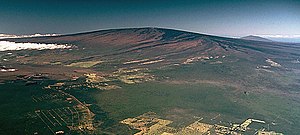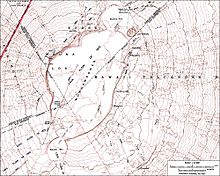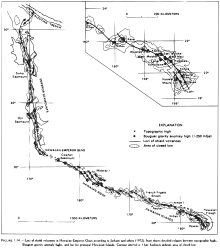Mauna Loa
| Mauna Loa | ||
|---|---|---|
|
Panorama of the Mauna Loa |
||
| height | 4170 m | |
| location | southern part of the island of Hawaii | |
| Coordinates | 19 ° 28 '9 " N , 155 ° 35' 42" W | |
|
|
||
| Type | Shield volcano | |
| rock | va. Tholeiite basalt | |
| Age of the rock | submarine estimated 1,000,000 years, above sea level M. approx. 400,000 | |
| Last eruption | March 24 - April 15, 1984 | |

The Mauna Loa is one of the largest active volcanoes in the world and is located in the Pacific to Hawaii , the largest island of the archipelago of Hawaii .
Surname
The Hawaiian name Mauna Loa means "long mountain", which is explained by its elongated shape from NNE to SSW.
location
The shield volcano occupies a large part of Hawaii , the largest island in the Hawaiian archipelago.
size
The mountain rises 4170 m , but extends a further 5000 m to its submarine foot in the sea. Scientists have calculated that due to the weight of the mountain, the sea floor below has sunk by around 8,000 m, so that the total height measured from the foot of the mountain is around 17,000 m.
Its length is about 120 km. It covers 5270 km² and has a volume of about 80,000 km³.
It is therefore the second largest (but not the highest) volcano in the world. Only the Pūhāhonu is larger with a volume of about 148,000 km³.
Structure of the volcano
It is an elongated shield volcano with a summit caldera measuring 3 × 5 km and having a depth of 183 m. This caldera is believed to have collapsed 600–750 years ago, in an older 6 × 8 km caldera. Mauna Loa is currently still in the 2nd development stage of volcanic ocean islands, the shield stage. The lower part of the volcano is around 1,000,000 years old and comes from the 1st construction stage, the seamount stage . This lower part is characterized by pillow lavas and hyaloclastites , the upper part mainly by tholeiite basalts of low viscosity .
As on many large volcanoes, there are also volcanic crevices on Mauna Loa , which in this case are responsible for the elongated shape of the volcanic structure. These are two axial rift zones that emanate from the summit crater Mokuaweoweo. Each of them contains magma-filled columns.
Eruption story
It is believed that the first eruptions in the system occurred 1,000,000 to 700,000 years ago. An estimated 400,000 years ago, the volcano passed the seamount stage and produced lavas and tephra , although the oldest rocks that can actually be clearly dated to date are around 200,000 years old.
Little is known of outbreaks during the period of purely Polynesian settlement, although archaeological finds of obsidian in the summit region can be considered evidence of ascents prior to contact with Europeans. When Archibald Menzies was the first European to reach the mountain top in 1794, there was probably no activity. A missionary's report on an eruption of the Mauna Loa is available from 1832, but the reporter was on the neighboring island of Maui , approx. 190 km away.
Since then, at least 33 eruptions of the Mauna Loa have been known up to the last one in 1984, 17 of them in the 19th century and 15 in the 20th century. An eruption in the 19th century lasted a whole year, from August 1871 to August 1872. A total of 4.1 km³ of lavas were produced.
The breakout series in 1950
After eruptions in 1907, 1919 and 1926, 1950 saw the most spectacular eruption of the Mauna Loa volcano in historical times.
The eruption was concentrated on the south-western flank of the mountain, with a 20 km long eruption crevice drawn across the rift zone. The eruptions followed the rhythm found on Mauna Loa, with a peak eruption usually leading to a flank eruption after about 1–2 years.
Although the eruption sites were about 3200 m above the Pacific , the lavas reached them in less than four hours. Numerous lava flows emerged from staggered crevices in the course of the eruptions, but the damage caused remained relatively minor. The ʻAʻā lavas of a lava flow poured down into the valley at a speed of up to 48 km / h. The flow of these lavas into the sea was particularly spectacular.
During the eruptions that lasted for 23 days, the volcano finally produced 376 million cubic meters of lavas, the eruption with the largest known discharge rate in Hawaii.
The 1984 eruption
Since the series of eruptions in 1975, increasing bulges had been found in the Mauna Loa volcano. This was joined by swarms of earthquakes in the spring of 1984, of which the deepest earthquakes were located at 13 km and the most violent reached a magnitude of 6.6. This suggested the intrusion of Dykes . Shortly before the eruptions began on March 24, 1984, the number of microquakes increased and volcanic tremor set in, so that the sensitive telescopes on Mauna Kea, 42 km away , could no longer be held still.
On March 25, the actual eruptions began with lava fountains in the southwest of the summit caldera. A large part of the caldera was covered with lava after just 2-3 hours. In the late afternoon, activity shifted to the northeastern rift zone approx. 650 m below the summit.
Over the next few days, the lava flows threatened the city of Hilo , but stopped at the edge of the same because the lava had finally spread over a wide slope area by breaking through Levees and no longer flowed in a few channels. In addition, their viscosity had increased due to cooling (ʻAʻā lava), the slope in front of the city was low and vegetation slowed down the lava flows. On April 15, the series of outbreaks ended.
Development in 2007 and situation in 2012
According to information from the Hawaiian Volcano Observatory , the following developments were observed in 2007:
Since the beginning of July 2004, an increasing number of volcanic tremors has been registered in the depths of Mauna Loa . The number of quakes fluctuated from week to week but was higher than normal. In the first week of September 2004 alone, there were more than 350 earthquakes at depths of 35 to 50 km. These were long-period earthquakes , the shock waves of which gradually emerge from the seismic background. This had not happened since records began in 1960.
The publication of a geophysical study in May 2007 generated a lot of media coverage. Some reports gave the impression that an outbreak was imminent. The Hawaiian Volcano Observatory noted in a May 21 report that there were no significant changes.
Like many calderas, such as Campi flegrei or Askja , Mauna Loa seems to "breathe". Immediately after the series of eruptions in 1984, an incipient bulge was noticed, but this turned into the opposite for several years. Only in 2002 did the volcano begin to bulge again, but this was slowed down again until 2009. Since 2010 there has only been a very slow bulge.
In autumn 2012, the volcano turned out to be calm. No significant bulging was found and only a few near-surface earthquakes and no noticeable gas emissions.
Hot spot
Mauna Loa and the other volcanoes in Hawaii, Mauna Kea , Hualālai and Kīlauea , were formed over a hot spot . Hot spots are areas where hot currents, so-called plumes , rise from the deep earth's mantle and transport material to the earth's surface. In the case of Hawaii , the region on the Pacific lithospheric plate is slowly pushed over the hot spot by plate tectonics , whereby a whole chain of volcanic islands and seamounts , the Hawaii-Emperor chain , was formed from the Aleutian Islands to in the middle of the Pacific.
This theory has also been used to explain the different composition of Mauna Loa lavas compared to Mauna Kea lavas . The tholeiitic basalts of Mauna Loa, a volcano that is in the stage of shield construction, are therefore the result of a position directly above the hot spot. Whereas Mauna Kea has already reached the next stage, is no longer directly above the hot spot, and produces basalts of the alkaline series. Some researchers explained this with different chemical composition zones of the mantle from which the magma would originate, others with different zoning of the ascending mantle plume.
Investigations into the vegetation at the Mauna Loa volcano
In 1997, investigations were carried out at Mauna Loa at six different locations on the growth of ironwood , a flowering shrub that resembles the rhododendron and is typical of the Pacific region. One wanted to test different vegetation conditions, especially the influence of altitude and temperature. As expected, it turned out that the plants settled in the lower layers (at approx. 700 m) thrived better than those at approx. 1600 m height. It seems interesting, however, that Mauna Loa was found to be particularly suitable for such tests for a number of reasons: Because of its isolated location, only a limited number of species thrive on the islands. In addition, there are cooled lava flows on the shield volcano, which cover many climatic areas, so that a very homogeneous picture of the soil results.
Myths and legends about Mauna Loa
One day , the volcano goddess Pele is said to have ridden a sled run incognito with Poliʻahu , the snow goddess of Mauna Kea. Suddenly, however, fire burst out of the earth and Poli'ahu recognized her enemy Pele.
One day, Pele is banished by her sister and seeks refuge in the gateway to the underworld, Mauna Loa, where she lives from then on.
Locals believe that before an eruption, the goddess Pele sends a white dog down the slopes of the mountain to warn people.
Observatories on the Mauna Loa
On the Mauna Loa there is the Mauna Loa measuring station , a meteorological measuring station that specializes primarily in carbon dioxide measurements, and an observatory .
Web links
Photos and videos
Scientific contributions
- Hawaiian Volcano Observatory / USGS
- Mauna Loa in the Global Volcanism Program of the Smithsonian Institution (English)
- Mauna Loa Observatory (MLO) NOAA
- Mauna Loa Solar Observatory (MLSO) - operated by the High Altitude Observatory, Boulder, Colorado
- Ken Hon, ea: Field interpretation of active volcanoes. A handbook for viewing lava , Geology Dept., University of Hilo, Hawaii, 2008 (PDF, English; 8.3 MB)
- Peter Schiffman: Hyaloclastites and the slope stability of Hawaiian volcanoes: Insights from the Hawaiian Scientific Drilling Project's 3-km drill core , Journal of Volcanology and Geothermal Research 151 (2006) 217–228 (PDF, English; 617 kB)
- Alexander V. Sobolev, ea: An olivine-free mantle source of Hawaiian shield basalts , NATURE, Vol. 434, 2005 (PDF, English; 1.1 MB)
- JW Raich, ea .: Primary Productivity and Ecosystem Development along an Elevational Gradient on Mouna Loa, Hawaii , Ecology , 78 (3), 1997, pp. 707-721 (PDF, English; 1.2 MB)
Individual evidence
- ↑ Mauna Loa in Place Names of Hawaii
- ↑ a b c d HVO: Mauna Loa Earth's Largest Volcano ; accessed: October 1, 2012
- ↑ Michael O. Garcia, Jonathan P. Tree, Paul Wessel, John R. Smith: Pūhāhonu: Earth's biggest and hottest shield volcano . In: Earth and Planetary Science Letters . Volume 542. Elsevier, April 18, 2020, doi : 10.1016 / j.epsl.2020.116296 .
- ↑ a b c d e http://hvo.wr.usgs.gov/maunaloa/history/main.html HVO: Mauna Loa. Eruption History , Retrieved January 20, 2012
- ↑ Mauna Loa in the Global Volcanism Program of the Smithsonian Institution (English)
- ↑ Peter Schiffman: Hyaloclastites and the slope stability of Hawaiian volcanoes: Insights from the Hawaiian Scientific Drilling Project's 3-km drill core ( Memento of the original from June 11, 2010 in the Internet Archive ) Info: The archive link was automatically inserted and not yet checked. Please check the original and archive link according to the instructions and then remove this notice. (PDF; 617 kB), Journal of Volcanology and Geothermal Research 151 (2006) 217-228; accessed: September 29, 2012
- ↑ Ken Hon, ea: Field interpretation of active volcanoes. A handbook for viewing lava , Geology Dept., University of Hilo, Hawaii, 2008, p. 48 (PDF; 8.3 MB); accessed: September 29, 2012
- ↑ http://www.geology.sdsu.edu/how_volcanoes_work/ Vic Camp: Fissure eruptions. How volcanoes work. San Diego State University; accessed: October 5, 2012
- ^ M. Steven Shackley: Archaeological Obsidian Studies: Method and Theory . Springer Science & Business Media, 2013, ISBN 9781475792768 , p. 116
- ↑ Walther M. Barnard: Earliest Ascents of Mauna Loa Volcano, Hawaiʻi . In: Hawaiian Historical Society, Honolulu (Ed.): Hawaiian Journal of History . 25, 1991.
- ↑ a b c d http://hvo.wr.usgs.gov/maunaloa/history/50_06_01/ HVO: 50th Anniversary of Mauna Loa's Most Spectacular Eruption ; retrieved. October 1, 2012
- ↑ a b c http://hvo.wr.usgs.gov/maunaloa/history/1984.html HVO: Mauna Loa - 1984 Eruption: March 25 - April 15 ; retrieved. October 1, 2012
- ↑ Falk Amelung, Sang-Ho Yun, Thomas R. Walter, Paul Segall, Sang-Wan Kim: Stress Control of Deep Rift Intrusion at Mauna Loa Volcano, Hawaii . IN: Science , May 18, 2007, Vol. 316, no. 5827, pp. 1026-1030. see table of contents
- ↑ Current Activity : "Report by Hawaiian Volcano Observatory on May 21, 2007: Mauna Loa is not erupting. There have been no significant changes. The recent newspaper publicity involving Mauna Loa was initiated by the publication, in the May 18 issue of the journal Science, of a several-year-long geophysical study by Dr. Falk Amelung detailing his ideas about what is happening beneath the volcano. The publicity was not initiated by any change in the behavior of Mauna Loa. "
- ↑ a b http://hvo.wr.usgs.gov/activity/maunaloastatus.php HVO: Recent Mauna Loa Status Reports, Updates, and Information Releases. HAWAIIAN VOLCANO OBSERVATORY MONTHLY UPDATE, Tuesday September 4, 2012 1:01 PM HST (Tuesday September 4, 2012 23:01 UTC); accessed: October 1, 2012
- ↑ Ken Hon, ea: Field interpretation of active volcanoes. A handbook for viewing lava , Geology Dept., University of Hilo, Hawaii, 2008, pp. 53ff. (PDF; 8.3 MB); accessed: September 29, 2012
- ↑ cf. z. B. TA Bianco, ea: Geochemical variation at the Hawaiian hot spot caused by upper mantle dynamics and melting of a heterogeneous plume , G3, Geochemistry, Geophysics, Geosystems, Vol. 9, Number 11, 2008 (PDF; 647 kB); doi: 10.1029 / 2008GC002111 ; accessed: September 30, 2012
- ↑ JW Raich, ea .: Primary Productivity and Ecosystem Development along an Elevational Gradient on Mouna Loa, Hawaii , Ecology , 78 (3), 1997, pp. 707 f .; accessed: September 29, 2012 (PDF; 1.2 MB)
- ↑ Poli'ahu in Hawaiian Dictionaries
- ↑ - ( Memento of the original from December 13, 2012 in the Internet Archive ) Info: The archive link was inserted automatically and has not yet been checked. Please check the original and archive link according to the instructions and then remove this notice. MythHome: Hawaiian Gods ; accessed: October 1, 2012
- ↑ http://www.trails.com/facts_11746_myth-legend-mauna-loa.html Trails: Myth & Legend About Mauna Loa ; accessed: October 1, 2012
- ↑ http://www.aloha-hawaii.com/big-island/mauna-loa/ Aloha - Hawaii: Mauna Loa ; accessed: October 1, 2012






